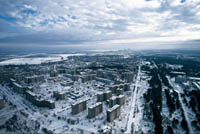When Chernobyl exploded liquidators were collecting pieces of uranium manually
The world was shocked to know about the nuclear disaster in Chernobyl 20 years ago, which undoubtedly became the biggest man-caused catastrophe of the 20th century. Chernobyl affected the lives of many people both inside and outside the USSR. Doctor of Technical Sciences, Igor Linge, said that there was no analogue in the world to judge upon the destruction of the nuclear reactor and the number of people who suffered from the tragedy.

Over 200,000 Soviet citizens participated in the liquidation of consequences caused with the explosion of the nuclear reactor of the Chernobyl power plant. The Soviet Union did its best to minimize the damage caused to people’s health although it was obviously impossible to get rid of all consequences.
The Chernobyl disaster does not seem to hide any secrets nowadays. A lot has been said and written about the catastrophe, the UN continues to receive volumes of scientific reports on the matter. Igor Linge is certain that the human factor was the main reason of the Chernobyl disaster. “The strategic mistakes that were made during the organization of protective measures after the explosion determined a larger scale of radioactive consequences,” the scientist said.
The Soviet authorities failed to react properly to the Chernobyl tragedy. It was particularly decided to resettle those living in radiation-polluted regions. Such a decision became a social shock for country residents, not to mention the economic decline which followed the resettlement from the disaster-affected territories. Young people left the polluted territories first. The area has been labeled as life-threatening although the radioactive background in other territories of Russia can be higher.
It goes without saying that other factors of the tragedy, such as immense psychological stress, for example, added more fuel to the fire and thus caused even more damage. Those ordered to leave their homes were allowed to take only their IDs and some food along. The people had to bid farewell to all their possessions. The disaster-stricken region with abandoned flats and stores became paradise to looters. Life stood still 30 kilometers around Chernobyl.
A nuclear reactor is a huge trench filled with graphite. The floor, the walls and the roof of the reactor are made of lead, which is the only radiation-proof substance on Earth. Shanks of uranium fuel are inserted in special inlets in the graphite. The nuclear reaction produces an enormous amount of heat. The energy of a palm-sized piece of uranium is comparable to the energy of a whole cargo train loaded with coal. The heat comes to steam turbines that produce electric current. The turbines are located at a special location above the reactor. The whole construction is covered with a cap.
It was impossible to approach the reactor during the first days after the explosion: the temperature in the reactor reached 5,000 degrees. The invisible cloud which appeared above the Chernobyl power plant sent radiation across Europe, mainly to Belarus and Ukraine. Liquidators tried to drop sand and water on the reactor from helicopters, but it was impossible to neutralize 77 kilos of radiation in the air.
When the reactor burnt out, specialists had to collect pieces of uranium and graphite scattered in the neighborhood. The work had to be conducted manually: dressed in lead suits and gas masks liquidators were picking up uranium from the ground and throwing it in the reactor. When the territory was cleaned engineers started building the sarcophagus above the reactor.
The Chernobyl power plant was shut down in December of 2000 because of the outdated security system.
Translated by Dmitry Sudakov
Discuss this article on Pravda.Ru English Forum
Subscribe to Pravda.Ru Telegram channel, Facebook, RSS!





